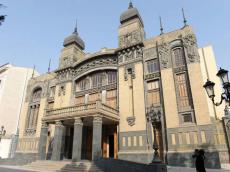|
|
TODAY.AZ / Arts & Entertainment
Azerbaijan State Academic Opera and Ballet Theater turns 100
07 July 2020 [15:27] - TODAY.AZ

By Azernews
By Laman Ismayilova
Medeniyyet TV continues to delight its viewers with numerous programmers, promoting Azerbaijan's rich cultural heritage.
This time, the channel provided insight into the country's opera art as part of "Bizi birl??dir?n m?d?niyy?t" (United by Culture) project.
The show was timed to the 100th anniversary of the Azerbaijan State Academic Opera and Ballet Theater.
The theater's chief director, Honored Artist of Azerbaijan Hafiz Guliyev as well as the soloists - Honored Artist Ilaha Efendieva, Jahangir Gurbanov and Farid Aliyev shared the history behind Azerbaijan State Academic Opera and Ballet Theater.
The theatre was built at the request of magnate Daniel Mailov and funded by magnate Zeynalabdin Taghiyev.
The theater's building was erected in 1910-1911. On October 18, 1918, the government of the Azerbaijan Democratic Republic (ADR) decided to officially turn this building into a state theater.
Since 1920, Azerbaijan State Academic Opera and Ballet Theater has been operating at the building.
The State Opera and Ballet Theater has played a major role in shaping the Azerbaijani opera art.
"Leyli and Majnun" by Uzeyir Hajibeyli, the first opera of the entire East, was first performed at the theater in 1908.
The opera laid the foundation of the new genre in musical culture of the world, which synthesizes oriental and European musical forms, resembling a dialogue of two musical cultures of East and West.
It was followed by multiple national operas such as "Sheikh Sanan" (1909), "Rustam and Zohrab" (1910), "Shah Abbas and Khurshid Banu" (1911), "Asli and Kerem"(1912), "Harun and Leyla" (1915), "Koroghlu " (1932).
Today, the theater continues to delight its guests with fascinating ballets, operas, and other theatrical performances.
Recently, Azerbaijan State Opera and Ballet Theater has entered the TOP 10 opera houses in the C?S.
The list was prepared by TurStat Agency for the International Day of Culture to mark the adoption of the Roerich Pact "on the Protection of Artistic and Scientific Institutions and Historical Monuments (1935)".
/t_MyCollages.jpg)
URL: http://www.today.az/news/entertainment/195202.html
 Print version
Print version
Connect with us. Get latest news and updates.
See Also
- 23 December 2024 [15:36]
Heydar Aliyev Palace to host concert timed to Tofig Ahmadov's centenary - 23 December 2024 [14:19]
Art of performing on balaban to be discussed in Baku - 23 December 2024 [11:25]
National Carpet Museum celebrates 530th anniversary of Muhammad Fuzuli - 22 December 2024 [17:22]
Charity fair in Dushanbe highlights Azerbaijani culture - 22 December 2024 [10:32]
Young archaeologists recognized for dedication to field research and public engagement - 20 December 2024 [17:52]
First ever Baku Book Festival draws book lovers from across country - 20 December 2024 [17:41]
Austrian label "Second Records" releases double vinyl record by Azerbaijani jazzman - 20 December 2024 [16:05]
Azerbaijan, Italy discuss prospects of cooperation in culture - 20 December 2024 [13:00]
Azerbaijani delegation visits Nizami Ganjavi monument in Rome - 20 December 2024 [12:22]
Baku Museum Center to hold concert dedicated to Honored Art Worker Javanshir Guliyev
Most Popular
 IDPs return to rebuilt Shusha as part of Great Return State Program
IDPs return to rebuilt Shusha as part of Great Return State Program
 Pashinyan plants a pig for the Armenians
Pashinyan plants a pig for the Armenians
 Azerbaijan, Russia inks agreement on Development of Transit Freight Transportation
Azerbaijan, Russia inks agreement on Development of Transit Freight Transportation
 Sweden's Climate and Environment Minister calls for Shein and Temu to be banned in country
Sweden's Climate and Environment Minister calls for Shein and Temu to be banned in country
 President Ilham Aliyev's remarks in his interview with Dmitry Kiselev in spotlight of world media
President Ilham Aliyev's remarks in his interview with Dmitry Kiselev in spotlight of world media
 S. Korea to launch 3rd homegrown military spy satellite
S. Korea to launch 3rd homegrown military spy satellite
 U.S. finalizes US$4.7 bln in CHIPS Act subsidy to Samsung Electronics
U.S. finalizes US$4.7 bln in CHIPS Act subsidy to Samsung Electronics
